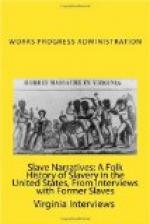It was hard after the war. The Federals stayed on for a long time. Fences were down, houses were burned, stock was gone, but we got along somehow. When Nora Blakeley was 14 a lady was teaching a subscription school in the hall across the street—the same hall Mrs. Blakely had saved from burning. She wanted Nora to teach for her. So, child that she was, she went over and pretty soon she was teaching up to the fourth grade. I went over every morning and built a fire for her before she arrived.
That fall she went over to the University, but the next year she had to stay out to earn money. She wanted to finish so badly that we decided to take boarders. They would come to us from way over on the campus. There were always lots more who wanted to stay than we could take. We bought silver and dishes just as we could pay for them, and we added to the house in the summer time. I used to cook their breakfasts and dinners and pack baskets of lunch for them to take over to the Campus. We had lots of interesting people with us. One was Jeff Davis—later he was governor and then senator. He and a Creek Indian boy named Sam Rice were great friends. There were lots of Indians in school at the University then. They didn’t have so many Indian schools and tribes would make up money and send a bright boy here.
Ten years after she graduated from the University Nora married Harvey M. Hudgins. They moved to Hot springs and finally ran a hotel. It burned the night of Washington’s birthday in 1895. It was terrible, we saved nothing but the night clothes we were in. Next morning it was worse for we saw small pox flags all over town. Our friends came to our rescue and gave us clothes and we went with friends out into the country to escape the epidemic. There were three or four families in one little house. It was crowded, but we were all friends so it was nice after all.
About ten years before Mr. Hudgins had built a building in Fayetteville. They used the second floor for an Opera House. When we came back here after the fire we took it over to run. Mr. Hudgins had that and all the billboards in town. We saw all the shows. Several years later the twins, Helen and Wade were born. I always went to see the shows and took them with me. Folks watched them more than the shows. I kept them neat and clean and they were so cute.
We saw the circuses too. I remember once Barnum and Bailey were coming to Fort Smith. We were going down. I didn’t tell anybody, but I put $45 in my purse. I made money then. Mr. Hudgins got me a cow and I sold milk and butter and kept all I made. Why the first evening dress Helen had and the first long pants Bud (Wade) had I bought. Well, we were going down to Fort Smith, but Bud got sick and we couldn’t go. You know, Mary, it seemed so queer. When Helen and I went to California, we all saw the same circus together. Yes, I’ve been to California with her twice. Whenever the train would stop she would come from the




